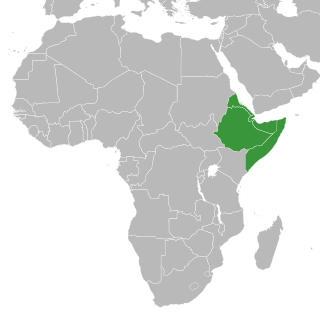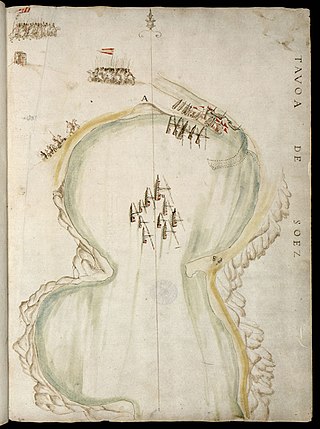
The 15th century was the century which spans the Julian calendar dates from 1 January 1401 to 31 December 1500 (MD).

The 16th century began with the Julian year 1501 and ended with either the Julian or the Gregorian year 1600 (MDC), depending on the reckoning used.

The Funj Sultanate, also known as Funjistan, Sultanate of Sennar or Blue Sultanate, was a monarchy in what is now Sudan, northwestern Eritrea and western Ethiopia. Founded in 1504 by the Funj people, it quickly converted to Islam, although this conversion was only nominal. Until a more orthodox form of Islam took hold in the 18th century, the state remained an "African empire with a Muslim façade". It reached its peak in the late 17th century, but declined and eventually fell apart in the 18th and 19th centuries. In 1821, the last sultan, greatly reduced in power, surrendered to the Ottoman Egyptian invasion without a fight.

The Dahlak Archipelago is an Eritrean island group located in the Red Sea, measuring around 643 square km and lying roughly 58 kilometers east of Massawa, the regional capital city. Consisting of two larger and 124 smaller islands, the local pearl fisheries of the archipelago have been famous since Roman times, and still produce a substantial number of pearls.

Suakin or Sawakin is a port city in northeastern Sudan, on the west coast of the Red Sea. It was formerly the region's chief port, but is now secondary to Port Sudan, about 50 kilometres (30 mi) north.

The Islamization of the Sudan region (Sahel) encompasses a prolonged period of religious conversion, through military conquest and trade relations, spanning the 8th to 16th centuries.

Habesh Eyalet was an Ottoman eyalet. It was also known as the Eyalet of Jeddah and Habesh, as Jeddah was its chief town, and Habesh and Hejaz. It extended on the areas of coastal Hejaz and Northeast Africa of Eritrea that border the Red Sea basin. On the Northeast Africa littoral, the eyalet comprised Suakin and their hinterlands.

Conflicts in the Horn of Africa have been occurring since the 17th century BCE. The Horn of Africa includes the modern day nation states of Djibouti, Eritrea, Ethiopia, and Somalia.
The Ottoman–Portuguese or the Turco-Portuguese confrontations refers to a series of different military encounters between the Portuguese Empire and the Ottoman Empire, or between other European powers and the Ottoman Empire in which relevant Portuguese military forces participated. Some of these conflicts were brief, while others lasted for many years. Most of these conflicts took place in the Indian Ocean, in the process of the expansion of the Portuguese Empire, but also in the Red Sea. These conflicts also involved regional powers, after 1538 the Adal Sultanate, with the aid of the Ottoman Empire, fought against the Ethiopian Empire, which was supported by the Portuguese, under the command of Cristóvão da Gama, the son of the famous explorer Vasco da Gama. This war is known as the Ethiopian–Adal war.

The Ottoman-Portuguese conflicts were a period of conflict during the Ottoman–Portuguese confrontations and series of armed military encounters between the Portuguese Empire and the Ottoman Empire along with regional allies in and along the Indian Ocean, Persian Gulf, and Red Sea.

The Khedivate of Egypt was an autonomous tributary state of the Ottoman Empire, established and ruled by the Muhammad Ali Dynasty following the defeat and expulsion of Napoleon Bonaparte's forces which brought an end to the short-lived French occupation of Lower Egypt. The Khedivate of Egypt had also expanded to control present-day Sudan, South Sudan, Eritrea, Djibouti, northwestern Somalia, northeastern Ethiopia, Lebanon, Jordan, Palestine, Syria, Greece, Cyprus, southern and central Turkey, in addition to parts from Libya, Chad, Central African Republic, Democratic Republic of Congo, and Uganda, as well as northwestern Saudi Arabia, parts of Yemen and the Kingdom of Hejaz.

The Ottoman–Mamluk War of 1516–1517 was the second major conflict between the Egypt-based Mamluk Sultanate and the Ottoman Empire, which led to the fall of the Mamluk Sultanate and the incorporation of the Levant, Egypt, and the Hejaz as provinces of the Ottoman Empire. The war transformed the Ottoman Empire from a realm at the margins of the Islamic world, mainly located in Anatolia and the Balkans, to a huge empire encompassing much of the traditional lands of Islam, including the cities of Mecca, Cairo, Damascus, and Aleppo. Despite this expansion, the seat of the empire's political power remained in Constantinople.

The Shilluk Kingdom, dominated by the Shilluk people, was located along the left bank of the White Nile in what is now South Sudan and southern Sudan. Its capital and royal residence were in the town of Fashoda. According to Shilluk folk history and neighboring accounts, the kingdom was founded by Nyikang, who probably lived in the second half of the 15th century. A Nilotic people, the Shilluk managed to establish a centralized kingdom that reached its apogee in the late 18th and early 19th centuries, during the decline of the northern Funj Sultanate. In the 19th century, the Shilluk were affected by military assaults from the Ottoman Empire, resulting in the destruction of the kingdom in the early 1860s. The Shilluk king is currently not an independent political leader, but a traditional chieftain within the governments of South Sudan and Sudan. The current Shilluk king is Reth Kwongo Dak Padiet who ascended to the throne in 1993.
The Hamaj Regency was a political order in modern-day central Sudan from 1762 to 1821. During this period the ruling family of the Funj Sultanate of Sennar continued to reign, while actual power was exercised by the regents.

The Battle of Benadir was an armed engagement between the Ajuran Sultanate and the Portuguese Empire.

The Kingdom of Fazughli was a precolonial state in what is now southeastern Sudan and western Ethiopia. Oral traditions assert its establishment to refugees from the Nubian Kingdom of Alodia, after its capital Soba had fallen to Arabs or the Funj in c. 1500. Centered around the mountainous region of Fazughli on the Blue Nile and serving as a buffer between the Funj sultanate and the Ethiopian empire, the kingdom lasted until its incorporation into the Funj sultanate in 1685.

Sudan and Turkey have enjoyed a relatively close relationship, owning by previous historical links between two countries since the Ottoman Empire. Due to this historical tie, Sudan and Turkey share an Ottoman legacy, though little comparing to other Arab states.

The Battle of Suez occurred in 1541 and was a failed attack by the Portuguese against the Ottomans.

The Battle of Suakin of 1541 was an armed encounter that took place in 1541 in the city of Suakin, held by the Ottoman Empire, and which was attacked, sacked and razed by Portuguese forces under the command of the Portuguese governor of India, Dom Estêvão da Gama.
















